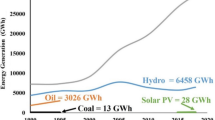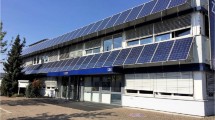Abstract
As renewable energies gain both in importance and in share of the global energy mix, questions arise as to whether they will face the same energy security challenges – such as terrorist attacks – that have confronted the oil and gas industry. This article addresses the risk of terrorism to the infrastructure associated with renewable energies and electrical power systems and transmission lines. It reviews the capacities of various risk assessment tools and analyzes the potential terrorist threat to the Desertec concept, which envisions meeting 15 per cent of Europe's electricity demand by 2050 with renewable energy sourced from the Middle East North Africa region. Some industry observers have already voiced grave concerns about potential European dependence on this region, specifically because of the presence of terrorist groups, including Al Qaeda, which was responsible for the 2001 attacks in the United States. The data for the Desertec case study analysis are partly informed by a series of interviews conducted with correspondents located in Europe and in North Africa.

Similar content being viewed by others
References
al Arousni, L. (2011) Al Qaeda seeking revenge against Morocco – Anti terrorism expert, http://www.asharq-e.com/news.asp?section=1andid=23683, accessed 25 June 2011.
Alexander, Y. (2010) Maghreb and Sahel Terrorism: Addressing the Rising Threat from al-Quada and other Terrorists in North and West/Central Africa. Arlington, Virginia, US: International Center for Terrorism Studies, the Potomac Institute for Policy Studies.
Alternative Energy Africa. (2010) Morocco announces winners for Ouarzazate solar project, http://ae-africa.com/read_article.php?NID=2640andPHPSESSID=6703c53153d5276c21c3f691291c97a6, accessed 16 May 2011.
Atwan, A.B. (2006) The Secret History of al Qaeda, 1st edn. Berkeley, CA: University of California Press.
Aven, T. (2008) Risk Analysis: Assessing Uncertainties Beyond Expected Values and Probabilities. Chichester, UK: John Wiley and Sons.
Aven, T. and Renn, O. (2009) The role of quantitative risk assessments for characterizing risk and uncertainty and delineating appropriate risk management options, with special emphasis on terrorism risk. Risk Analysis 29 (4): 587–600.
Baker, S., Waterman, S. and Ivanov, G. (2009) In the Crossfire: Critical Infrastructure in the Age of Cyber War. Santa Clara, CA: McAfee, Inc.
BBC. (2009) Profile: Al-Qaeda in North Africa, http://news.bbc.co.uk/2/hi/africa/6545855.stm, accessed 27 October 2011.
Beckman, K. (2010) It is essential to get political support, http://www.europeanenergyreview.eu/site/pagina.php?id=1827, accessed 17 May 2011.
Boin, A. and Smith, D. (2006) Terrorism and critical infrastructures: Implications for public–private crisis management. Public Money & Management 26 (5): 295–304.
Botha, A. (2008) Terrorism in the Maghreb, ISS Monograph Series Pretoria, South Africa: Institute for Security Studies.
BP. (2011) Statistical review of world energy. London, http://www.bp.com/sectionbodycopy.do?categoryId=7500&contentId=7068481, accessed 28 September 2011.
Brayley, H., Redfern, M.A. and Bo, Z.Q. (2005) The Public Perception of Power Blackouts. IEEE/PES Transmission and Distribution Conference and Exhibition: Asia and Pacific; 15–17 August, Dalian, China: IEEE.
Brown, G.G. and Louis Anthony Cox, J. (2011a) How probabilistic risk assessment can mislead terrorism risk analysts. Risk Analysis 31 (2): 196–205.
Brown, G.G. and Louis Anthony Cox, J. (2011b) Terrorism risk analysis less harmful and more useful: Another try. Risk Analysis 31 (2): 193–195.
Church, R.L., Scaparra, M.P. and Middleton, R.S. (2004) Identifying critical infrastructure: The median and covering facility interdiction problems. Annals of the Association of American Geographers 94 (3): 491–502.
Criekemans, D. (2011) The Geopolitiics of Renewable Energy: Different or Similar to the Geopolitics of Conventional Energy? Global Governance: Political Authority in Transition, ISA Annual Convention; Montreal, Quebec, Canada.
Cupp, S. and Spight, M.G. (2007) A homeland security model for assessing US domestic threats. Professional Issues in Criminal Justice: A Professional Journal 2 (1): 51–52.
Department of Homeland Security. (2009) National infrastructure protection plan: Partnering to enhance protection and resiliency, http://www.dhs.gov/xlibrary/assets/NIPP_Plan.pdf, accessed 2 November 2011.
Department of Justice. (2005) Assessing and managing the terrorism threat, US department of justice: Office of justice programs. Washington DC, https://www.ncjrs.gov/pdffiles1/bja/210680.pdf, accessed 2 November 2011.
Dii. (2009) Our mission, http://www.dii-eumena.com/home/our-mission.html, accessed 7 January 2011.
Dii. (2011) Masen (Moroccan Agency for Solar Energy) and the industrial consortium Dii agree on a co-operation project, http://www.dii-eumena.com, accessed 25 May 2011.
Ebinger, C. and Massey, K. (2011) Software and Hard Targets: Enhancing Smart Grid Cyber Security in the Age of Information Warfare. Brookings, Washington DC: Energy Security Initiative, Brookings Institution.
Economist Intelligence Unit. (2011) Algeria alternatives: Sub-sector update, http://www.eiu.com/index.asp?layout=ib3PrintArticleandarticle_id=1437841528andprinter=printerandrf=0, accessed 14 May 2011.
ESTELA. (2009) Solar from the sun belt, http://www.estelasolar.eu/fileadmin/ESTELAdocs/documents/2009_-_ESTELA_-_MSP_17_-_09_07_06__FINAL_.pdf, accessed 3 April 2010.
Ezell, B.C., Bennett, S.P., von Winterfeldt, D., Sokolowski, J. and Collins, A. (2010) Probabalistic risk analysis and terrorism risk. Risk Analysis 30 (4): 575–589.
Fedorowicz, J.K. (2007) The Ten-Thousand Mile Target: Energy Infrastructure and Terrorism Today, The Norman Paterson School of International Affairs. Ottawa, ON, Canada: Carleton University, Canadian Centre of Intelligence and Security Studies (CCISS).
German Aerospace Center (Deutsches Zentrum fuer Luft- und Raumfahrt). (2006) Trans-Mediterranean Interconnection for Concentrating Solar Power. Stuttgart, Germany: Institute of Technical Thermodynamics.
Giroux, J. (2009) Targeting energy infrastructure: Examining the terrorist threat in North Africa and its broader implications (ARI), http://www.realinstitutoelcano.org/wps/portal/rielcano_eng/Content?WCM_GLOBAL_CONTEXT=/elcano/elcano_in/zonas_in/ari25-2009, accessed 3 February 2010.
Gleason, J.M. (1988) Questionable assumptions in terrorist risk analysis. Risk Analysis 8 (1): 9–11.
Granadino, R. and Mansouri, F. (2007) A bridge between two continents, http://tdworld.com/underground_transmission_distribution/power_bridge_two_continents/, accessed 18 May 2011.
Guarniere, M.R. (2008) Elmed project: Technical characteristics of the interconnection and Terna HVDC experience, http://www.industrie.gov.tn/fr/projetelmed/images/pdf/9_1_characteristics_interconnection.pdf, accessed 15 May 2011.
Haimes, Y.Y. and Longstaff, T. (2002) The role of risk analysis in the protection of critical infrastructures against terrorism. Risk Analysis 22 (3): 439–444.
Hansen, A. and Vriens, L. (2009) Al-Qaeda in the Islamic Maghreb (AQIM), http://www.cfr.org/north-africa/al-qaeda-islamic-maghreb-aqim/p12717, accessed 27 October 2011.
Human Rights Watch. (2011) Morocco: Marrakesh bombing abhorrent, http://www.hrw.org/en/news/2011/04/29/morocco-marrakesh-bombing-abhorrent, accessed 25 June 2011.
Jopling, M. (2008) Energy security: Co-operating to enhance the protection of critical energy infrastructures, http://www.nato-pa.int/default.asp?CAT2=1458andCAT1=16andCAT0=2andCOM=1478andMOD=0andSMD=0andSSMD=0andSTA=0andID=0andPAR=0andLNG=0, accessed 6 April 2010.
Keeney, G.L. and Winterfeldt, D.V. (2010) Identifying and structuring the objectives of terrorists. Risk Analysis 30 (12): 1803–1816.
Komendantova, N., Patt, A., Barras, L. and Battaglini, A. (2009) Perception of risks in renewable energy projects: The case of concentrated solar power in North Africa. Energy Policy 40 (January): 103–109.
Kroeger, W. (2010) Emerging risks related to large-scale engineered systems. International Risk Governance Council, October, http://www.irgc.org/IMG/pdf/Large_scale_engineered_systems_Kroeger.pdf, accessed 12 May 2011.
Kunreuther, H. (2002) Risk analysis and risk management. Risk Analysis 22 (4): 655–664.
Lilliestam, J. and Ellenbeck, S. (2011) Energy security and renewable electricity trade – Will Desertec make Europe vulnerable to the ‘energy weapon’? Energy Policy 39 (6): 3380–3391.
Lipton, J. (2007) Al-Qaeda in North Africa: Local and global Jihad, http://www.washingtoninstitute.org/templateC05.php?CID=2592, accessed 26 October 2011.
Lubbadeh, J. (2009) Can Saharan solar power save Europe? Der Spiegel, 12 March, http://www.spiegel.de/international/germany/0,1518,664842-7,00.html, accessed 17 May 2011.
Martz, H.F. and Johnson, M.E. (1987) Risk analysis of terrorist attacks. Risk Analysis 7 (1): 35–47.
Masse, T., O'Neil, S. and Rollins, J. (2007) The Department of Homeland Security's Risk Assessment Methodology: Evolution, Issues, and Options for Congress. Washington DC: Congressional Research Service.
Masters, J. (2011) Confronting the Cyber Threat. New York: Council on Foreign Relations.
Mekhennet, S. and Erlanger, S. (2011) Protesters in Morocco seek quicker shift to democracy and denounce terror. New York Times 1 May.
Minkel, J. (2008) The 2003 Northeast blackout – five years later. Scientific American 13 August.
Nerlich, U. and Umbach, F. (2009) Kritikalitaetsanalyse der EU-Gasinfrastruktur: Erhoehte Sicherheitsanforderungen an Gasleit- und –kontrollzentren. Energiewirtschaftliche Tagesfragen.
Norton Rose Group. (2010) Moroccan plan for solar energy, http://www.nortonrose.com/knowledge/publications/pdf/file31552.pdf?lang=en-gb, accessed 12 May 2011.
OECD/International Energy Agency. (2005) Learning from the Blackouts. Paris, France: International Energy Agency.
Porter, G.D. (2009) AQIM and the growth of international investment in North Africa. CTC Sentinel.
Rudner, M. (2006) Protecting North America's energy infrastructure against terrorism. International Journal of Intelligence and Counterintelligence 19 (3): 424–442.
Rudner, M. (2008a) Protecting Canada's Energy Infrastructure Against Terrorism: Mapping a Proactive Strategy. Ottawa, Canada: Canadian Centre of Intelligence and Security Studies. Critical Energy Infrastructure Protection Policy Research Series no. 1.
Rudner, M. (2008b) Protecting critical energy infrastructure through intelligence. International Journal of Intelligence and CounterIntelligence 21 (4): 635–660.
Ryu, D.H., Kim, H. and Um, K. (2009) Reducing security vulnerabilities for critical infrastructure. Journal of Loss Prevention in the Process Industries 22 (6): 1020–1024.
Rzhevskiy, I. (2009) World's most daring solar energy project coming to fruition, http://www.theepochtimes.com/n2/content/view/18824/, accessed 19 May 2011.
Shull, A. (2006) Assessment of Terrorist Threats to the Canadian Energy Sector, Canadian Centre of Intelligence and Security Studies (CCISS). Ottawa, ON, Canada: The Norman Paterson School of International Affairs, Carleton University.
Simonoff, J.S., Restrepo, C.E. and Zimmerman, R. (2007) Risk-management and risk-analysis-based decision tools for attacks on electric power Risk Analysis 27 (3): 547–570.
START. (2011) Terrorist Organizations in Morocco. College Park, Maryland: National Consortium for the Study of Terrorism and Responses to Terrorism (START) at University of Maryland.
Toft, P., Duero, A. and Bieliauskas, A. (2010) Terrorist targeting and energy security. Energy Policy 38 (8): 4411–4421.
Trieb, F. and Müller-Steinhagen, H. (2009) The Desertec concept: Sustainable electricity and water for Europe, Midde East and North Africa. Desertec White Paper, February, 23–42.
Trieb, F., O'Sullivan, M., Pregger, T., Schillings, C. and Krewitt, W. (2009) Characterisation of Solar Electricity Import Corridors from MENA to Europe: Potential, Infrastructure and Cost. Stuttgart, Germany: DLR (German Aerospace Center).
Ummel, K. and Wheeler, D. (2008) Desert power: The Economics of solar thermal electricity for Europe, North Africa, and the Middle East. Washington DC: Center for Global Development, Center for Global Development. Working Paper 156.
US Government Accountability Office. (2007) Homeland security grants: Observations on process DHS used to allocate funds to selected urban areas, http://www.gao.gov/products/GAO-07-381R, accessed 3 November 2011.
US Government Accountability Office. (2008) DHS risk-based grant methodology is reasonable, but current version's measure of vulnerability is limited. Report to Congressional Committees, http://www.gao.gov/products/GAO-08-852, accessed 3 November 2011.
van der Vleuten, E. and Lagendijk, V. (2010) Transnational infrastructure vulnerability: The historical shaping of the 2006 European ‘Blackout’. Energy Policy 38 (4): 2042–2052.
Watts, D. (2003) Security and Vulnerability in Electric Power Systems, 35th North American Power Symposium, University of Missouri-Rolla, Rolla, Missouri.
Wiese, A., Kleineidam, P., Schallenberg, K., Ulrich, A.J. and Kaltschmitt, M. (2010) Renewable power generation – A status report, http://www.renewableenergyfocus.com/view/14432/renewable-power-generation-a-status-report/, accessed 19 May 2011.
World Bank. (2011) Egypt and Morocco: Concentrated solar power, http://go.worldbank.org/2ROW5H1010, accessed 17 May 2011.
Yergin, D. (2006) Ensuring energy security. Foreign Affairs 85 (2): 69–82.
Acknowledgements
The authors wish to thank the reviewers and editors for their feedback and support, as well as Christine Brandstaett and Martin Palovic of the Bremer Energie Institut and Ioana Bedreaga of Jacobs University for their helpful contributions. We also express our gratitude to Franz Trieb and his colleagues at the Deutsches Zentrum fuer Luft- und Raumfahrt (German Aerospace Center) for allowing us to use their map of the potential transmission infrastructure connecting European demand centers and concentrated solar power sites in the Middle East North Africa region.
Author information
Authors and Affiliations
Rights and permissions
About this article
Cite this article
Smith Stegen, K., Gilmartin, P. & Carlucci, J. Terrorists versus the Sun: Desertec in North Africa as a case study for assessing risks to energy infrastructure. Risk Manag 14, 3–26 (2012). https://doi.org/10.1057/rm.2011.15
Published:
Issue Date:
DOI: https://doi.org/10.1057/rm.2011.15




